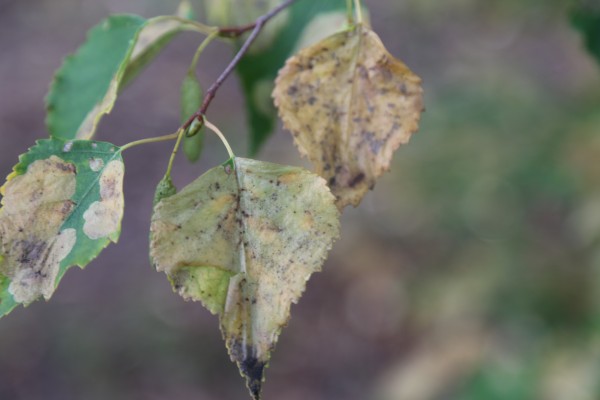Birch trees face increasing challenges
September 16, 2014

Nancy Tarnai
907-474-5042
9/17/2014
The hot, dry summer of 2013, coupled with the arrival of the amber-marked birch leaf miner, is taking a toll on Interior Alaska's birch trees.
“It’s a bad combination,” University of Alaska Fairbanks professor Glenn Juday said. “The trees were in a weakened condition from the drought, and then this insect comes along. This could be the perfect storm.
“We’re taking a serious hit to our birches,” said Juday, who has been researching climate change in northern forests for 35 years. “They’re in terrible shape. The leaves are showing acute drought stress. It’s pretty depressing.”
The National Weather Service blog, Deep Cold, reports: “The summer of 2013 brought the highest vapor pressure deficit in the Fairbanks record, which extends back to 1950. Using hourly temperature readings, mean temperature in the June to August 2013 time period was more than two degrees Celsius above the 1981-2010 normal. Another indication of the dryness of the atmosphere is that the mean dewpoint was 0.2 degrees centigrade below normal.”
“Our birch trees were really seriously hurt by the events of 2013-2014,” Juday said. “We are pushing the envelope of conditions outside the boundaries this tree had adapted to here.”
The amber-marked birch leaf miner appeared in the Anchorage area a decade ago. “We wondered if it would come this far north,” Juday said. “The answer is now in. Yes, it has.”
With the birch decline or die-back in progress, now each of the major commercially valuable tree species in the Interior has been hit hard.
“The unhealthy forest in the Interior is not only due to a cyclical outbreak of insects,” he said. “There are issues like this in major parts of the boreal forest around the world; this could affect its future abundance.”
Birches, which make up about 18 percent of the Alaska boreal forest, have unique properties, including condensable sap and the highest energy content among native firewood species. The white-barked trees drop their leaves in winter, letting the sun shine through.
While birches in the Interior are suffering, places where growing conditions previously were marginal are now becoming more suitable habitat. “In western Alaska, the cooler summers have allowed more growth of white spruce, and presumably birch, than we’ve seen in the last several hundred years,” Juday said.
Affected Interior birch trees have sparse foliage, small leaves and dead upper branches. Where the insides of the trees have hollowed due to stress, heart rot is occurring.
“This is not simply a disaster story," Juday said. "We know more than that. There are challenges we need to be prepared to deal with. How do we sustain the yield when the environment is changing so radically? This is wholesale tree death and migration. We have to think about this at a very large scale.”
Scientists need to work with natural resources managers in a constructive way to deal with the situation, Juday said. “Should we assist in the migration or watch and preside over the death? This is unprecedented. There are challenging years ahead of us.”
UAF Cooperative Extension Service forester Glen Holt is fielding many calls about birch tree problems. His advice to landowners is to monitor the size, age and health of their birch trees, noting problems that seem most likely evident around July each year. Older birch trees with rot evident in their tree trunks are prone to wind breakage. Birch trees with their roots compacted by sidewalks, driveways, wood piles, dogs and people traffic are most susceptible to all the birch forest health problems.
“Many of our birch are getting older, and they are less able to fight off forest pests especially when combined with dry springs,” Holt said.
“It is amazing to note this year that we are affected by various birch tree problems even in light of a wet summer," he said. “I advise people to water their trees in the spring if drying is a prolonged situation."
Other advice:
• Don't pile wood or other things on or next to tree roots.
• Don't put soil on or around birch trees during construction, and be careful not to damage birch tree trunks.
• Don't expect birches to survive long after any of these mechanical damages, because their roots get smothered by topsoil and rot/fungus enters the tree trunk from wounds.
James Kruse, forest entomologist for the U.S. Department of Agriculture's Forest Service, said rust fungus also is stressing birch trees this year.
“As for how much of the Melampsoridium botulinum rust we saw, Steve Swenson (USDA Forest Service biological technician) reported that about 75 to 80 percent of the birch examined in the Mat-Su Valley (Aug. 18-22) had at least a little of this rust," Kruse said. "Also, I think maybe 95 percent of the birch that we observed from the ground are experiencing a heavy catkins year. … More of the tree’s energy may be going to the catkins. Thus, less energy is available to make leaves, therefore causing thinner crowns.
“Just another thing to add to the myriad of things going on with birch.”
NT/9-17-14/051-15


